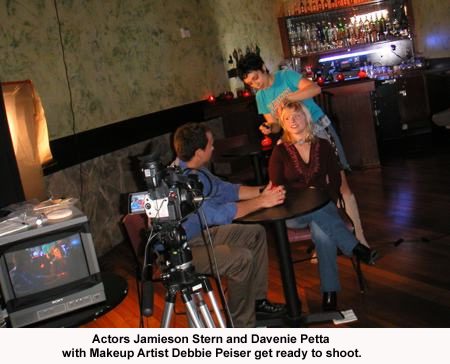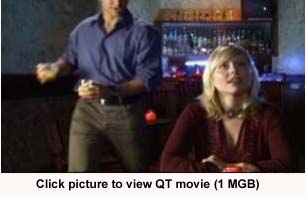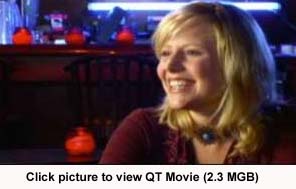
by Noah Kadner
David Mullen
was kind enough to volunteer his time as the cinematographer
for this shoot. David is uniquely qualified for this test, having
shot many features on film as well as a handful on professional
HD 24p equipment such as the Sony HDW F-900. Michael Horton from
2-pop and the Los Angeles Final Cut Pro User Group also jumped
on board to line up extra help and equipment donations.
PRODUCTION
We set up a typical interior dialogue scene in a bar at the Knitting
Factory in Hollywood. Our crew and lighting package were
small, reflecting the normal constraints of indie production.
The equipment consisted of a couple of KinoFlo 4-foot 4 banks,
some Kino singles, and two 150 watt Dedolight kits donated by
KinoFlo. We also had a
dolly, jib arm and monitor donated by ProMax.
Everyone who worked on the one-day shoot was generous enough
to do so as a volunteer.
The DVX100 was set up in the 24p advanced
mode, Cine Gamma, Cine Matrix and thin vertical resolution. As
an experiment, David created a separate scene file for shooting
tighter close-ups on the DVX100 where the sharpness was set almost
to the lowest setting, instead of using any diffusion filters,
for a softer look. The PD150 was set in 60i mode, with default
sharpness and gamma settings. Since neither camera has native
16:9, we shot both in 4:3 while masking off the widescreen area
on the camera viewfinders and our production monitor for latter
matting in post.
 Whenever possible
we tried to align both cameras so that they were filming nearly
identical shots for each take. We used our large production monitor
to do A/B comparisons on set to guarantee similar shot sizes
and exposure settings. On the monitor, the aesthetic effect of
shooting 24p mode on the DVX100 was immediately noticeable in
contrast to the more traditional 60i video look of the PD150.
While the PD150 gave a more saturated color palette, the DVX100
looked more like film not just in motion reproduction, but tonal
values. David felt that the DVX100 had more detail in the shadows
and a smoother look in general, a little less harsh and edgy-looking
compared to the PD150. For an indie director like me, that signature
look was a welcome and exciting achievement.
Whenever possible
we tried to align both cameras so that they were filming nearly
identical shots for each take. We used our large production monitor
to do A/B comparisons on set to guarantee similar shot sizes
and exposure settings. On the monitor, the aesthetic effect of
shooting 24p mode on the DVX100 was immediately noticeable in
contrast to the more traditional 60i video look of the PD150.
While the PD150 gave a more saturated color palette, the DVX100
looked more like film not just in motion reproduction, but tonal
values. David felt that the DVX100 had more detail in the shadows
and a smoother look in general, a little less harsh and edgy-looking
compared to the PD150. For an indie director like me, that signature
look was a welcome and exciting achievement.
We did discover some potentially major
issues while shooting with the DVX100. David's strongest complaint
was the DVX100's lens and its lack of certain crucial manual
controls. Focus was a constant problem. The DVX100 provides a
typical 'infinity servo' type of focus. This means you can turn
the focus ring forever and it won't stop once you hit infinity
or macro. It also has no barrel markings. This made hitting focus
marks and pulling racks much more difficult than it would be
with a traditional film camera or higher end video camera. Of
course, the PD150 and most other prosumer DV cameras with the
exception of the Canon
XL1s have this same limitation. The DVX100 also doesn't have
autofocus in 24p mode which makes dolly, crane and Steadicam
shots difficult. Hopefully the manufacturers will someday realize
this level of automation is a limitation not a plus.
POST PRODUCTION
All camera tapes were digitized via Firewire into Final Cut Pro
3.02 and set up in a 29.97 timeline. Future versions of Final
Cut promise native 24p import from the DVX100. Selected takes
were edited on a parallel timeline, which allowed us to switch
back and forth between each cameras' view of the scene. The finished
edit was output as a 29.97 FCP reference movie and then output
back to DV tape via Firewire.
We also took selected takes from each
camera and sent them to Marcus van Bavel of DVFilm
in Austin, Texas for digital film recording. Marcus was kind
enough to donate the film outs for our test. He also provided
the use of the DVFilm
Maker software which allowed us to remove the 2:3:3:2 pulldown
from the DVX100 clips. We were then able to save true 24p QuickTime
files from the DVX100 along with the 29.97 material from the
PD150 onto CD-ROMs and ship them to DVFilm for film out.
CONCLUSIONS
Viewing the A/B edit of the test was quite illuminating. As it
had appeared on set, the DVX100 footage exhibited an image approaching
a traditional film look, while the PD150 rendered the scene more
toward a documentary or news video look. Both cameras are capable
of undeniably excellent imagery but to my eyes the difference
was night and day.
 The footage we sent to DVFilm arrived on 35mm
film and we screened the print at a local screening room. Here
the difference was much less pronounced. Both cameras produced
a satisfying image with excellent color saturation and surprising
sharpness. The DVX100 was somewhat sharper with greater shadow
detail while the PD150 exhibited a warmer palette and moderately
increased contrast. Marcus commented that his CRT film recorder
was calibrated to normal DV gamma and he would be making new
adjustments to account for the gamma curve of the DVX100. The
motion of both cameras was remarkably similar. According to Marcus,
this is due in large part to the improvements in the software
he uses to interpolate 60i material to 24p.
The footage we sent to DVFilm arrived on 35mm
film and we screened the print at a local screening room. Here
the difference was much less pronounced. Both cameras produced
a satisfying image with excellent color saturation and surprising
sharpness. The DVX100 was somewhat sharper with greater shadow
detail while the PD150 exhibited a warmer palette and moderately
increased contrast. Marcus commented that his CRT film recorder
was calibrated to normal DV gamma and he would be making new
adjustments to account for the gamma curve of the DVX100. The
motion of both cameras was remarkably similar. According to Marcus,
this is due in large part to the improvements in the software
he uses to interpolate 60i material to 24p.
 The appeal of 24p is an aesthetic rather than
technical one. While the PD150's capabilities are sound and the
image is sharp, the DVX100 produced imagery I would normally
expect to see from a film camera. Considering the drastic price
difference between shooting on the DVX100 and shooting on film,
this is an exciting time. If you want to shoot a feature that
looks like a big budget Hollywood movie, but you don't have the
funding to shoot on film, the DVX100 can provide an effective
alternative. This camera will not give you that look out of the
box, but when pressed it can achieve amazing results. There is
always the possibility of shooting with a 60i camera and adding
a filmlook process in post. The main disadvantage to this approach
is the added post-production time as many film look plug-ins
demand major rendering time to achieve the desired effect.
The appeal of 24p is an aesthetic rather than
technical one. While the PD150's capabilities are sound and the
image is sharp, the DVX100 produced imagery I would normally
expect to see from a film camera. Considering the drastic price
difference between shooting on the DVX100 and shooting on film,
this is an exciting time. If you want to shoot a feature that
looks like a big budget Hollywood movie, but you don't have the
funding to shoot on film, the DVX100 can provide an effective
alternative. This camera will not give you that look out of the
box, but when pressed it can achieve amazing results. There is
always the possibility of shooting with a 60i camera and adding
a filmlook process in post. The main disadvantage to this approach
is the added post-production time as many film look plug-ins
demand major rendering time to achieve the desired effect.
In order to reap the benefits of the
DVX100, you need an excellent cinematographer who understands
how to light and compose. You also need the time and talented
crew to achieve high production value down the line. I look forward
to more cameras as the major manufacturers begin to implement
24p on more cameras. The bounds between the dreams we have and
the films we can achieve are no longer monetary but based purely
on raw talent.
NOTES: Special thanks to Charles McConathy
and ProMax for hosting these
QT movies. For a DVD featuring the test shoot in its entirety,
please contact ProMax.
Click HERE for full resolution JPEG comparison
(140k)
CREDITS
High Road Productions Presents
|
Produced and Directed By
Noah Kadner
Written By
Herschel Arlo Faber
Director of Photography
M. David Mullen
Starring
Jamieson Stern
Davenie Petta
Sound Mixer
Bill Robbins
PD150 Operator
Terrence McCarthy
|
Makeup
Debbie Peiser
Production Assistants
Kevin Mucha
David Chai
Production Equipment and Support Donated
By
ProMax
www.ProMax.com
KinoFlo
www.kinoflo.com
DVFilm
www.dvfilm.com
Special Thanks To:
Michael Horton
Charles McConathy
Marcus van Bavel
|
copyright©Noah Kadner
2003
Noah
Kadner lives in Los Angeles and runs High
Road Productions, a film, television, production and post-production
company. Noah's work, such as his award-winning short "Today's
Life," has been screened at San Diego ComiCon, UCLA Shorttakes,
USC First Look, Hollywood Shorts Film Festival, IFILM, AtomFilms
and the Sci-Fi Channel -- in an interview that you can see here: